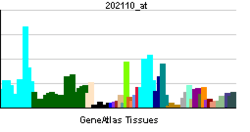COX7B
Cytochrome c oxidase subunit 7B, mitochondrial is an enzyme that in humans is encoded by the COX7B gene.[1][2]
Cytochrome c oxidase (COX), the terminal component of the mitochondrial respiratory chain, catalyzes the electron transfer from reduced cytochrome c to oxygen. This component is a heteromeric complex consisting of 3 catalytic subunits encoded by mitochondrial genes and multiple structural subunits encoded by nuclear genes. The mitochondrially-encoded subunits function in electron transfer, and the nuclear-encoded subunits may function in the regulation and assembly of the complex. This nuclear gene encodes subunit VIIb, which is highly similar to bovine COX VIIb protein and is found in all tissues. This gene may have several pseudogenes on chromosomes 1, 2, 20 and 22, respectively.[2]
References
- ↑ Sadlock JE, Lightowlers RN, Capaldi RA, Schon EA (Mar 1993). "Isolation of a cDNA specifying subunit VIIb of human cytochrome c oxidase". Biochim Biophys Acta 1172 (1–2): 223–5. doi:10.1016/0167-4781(93)90301-s. PMID 8382530.
- 1 2 "Entrez Gene: COX7B cytochrome c oxidase subunit VIIb".
Further reading
- Lenka N, Vijayasarathy C, Mullick J, Avadhani NG (1998). "Structural organization and transcription regulation of nuclear genes encoding the mammalian cytochrome c oxidase complex". Prog. Nucleic Acid Res. Mol. Biol. Progress in Nucleic Acid Research and Molecular Biology 61: 309–44. doi:10.1016/S0079-6603(08)60830-2. ISBN 978-0-12-540061-9. PMID 9752724.
- Van Kuilenburg AB, Van Beeumen JJ, Van der Meer NM, Muijsers AO (1992). "Subunits VIIa,b,c of human cytochrome c oxidase. Identification of both 'heart-type' and 'liver-type' isoforms of subunit VIIa in human heart". Eur. J. Biochem. 203 (1–2): 193–9. doi:10.1111/j.1432-1033.1992.tb19847.x. PMID 1309697.
- Stroh A, Kadenbach B (1986). "Tissue-specific and species-specific distribution of -SH groups in cytochrome c oxidase subunits". Eur. J. Biochem. 156 (1): 199–204. doi:10.1111/j.1432-1033.1986.tb09568.x. PMID 3007143.
- Possekel S, Marsac C, Kadenbach B (1996). "Biochemical analysis of fibroblasts from patients with cytochrome c oxidase-associated Leigh syndrome". Biochim. Biophys. Acta 1316 (3): 153–9. doi:10.1016/0925-4439(96)00005-1. PMID 8781533.
- Nijtmans LG, Taanman JW, Muijsers AO, et al. (1998). "Assembly of cytochrome-c oxidase in cultured human cells". Eur. J. Biochem. 254 (2): 389–94. doi:10.1046/j.1432-1327.1998.2540389.x. PMID 9660196.
- Strausberg RL, Feingold EA, Grouse LH, et al. (2003). "Generation and initial analysis of more than 15,000 full-length human and mouse cDNA sequences". Proc. Natl. Acad. Sci. U.S.A. 99 (26): 16899–903. doi:10.1073/pnas.242603899. PMC 139241. PMID 12477932.
- Gerhard DS, Wagner L, Feingold EA, et al. (2004). "The status, quality, and expansion of the NIH full-length cDNA project: the Mammalian Gene Collection (MGC)". Genome Res. 14 (10B): 2121–7. doi:10.1101/gr.2596504. PMC 528928. PMID 15489334.
- Ross MT, Grafham DV, Coffey AJ, et al. (2005). "The DNA sequence of the human X chromosome". Nature 434 (7031): 325–37. doi:10.1038/nature03440. PMC 2665286. PMID 15772651.
